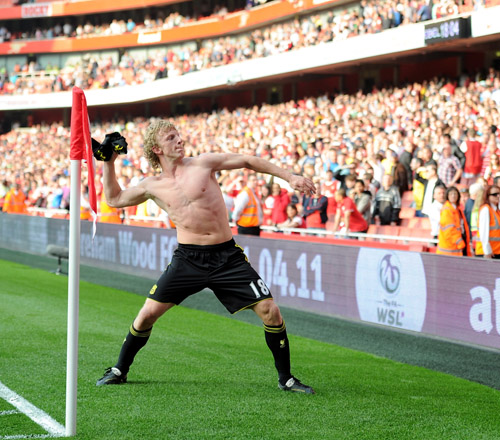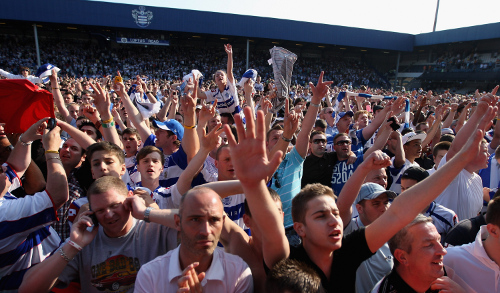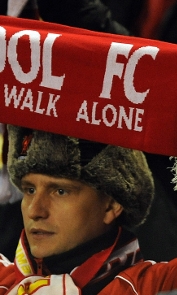2011-12 preview: Away days
With the new season just a week away, we're taking you on a tour of the Barclays Premier League stadiums, looking at the places you'll encounter during 2011-12 and finding out great facts like why Grimsby Town attract more fans that Man Utd.
Emirates Stadium
Club: Arsenal
Capacity: 60,355
Initially known as Ashburton Grove, the Emirates is the second largest club ground in England after Manchester United's Old Trafford. Opened in July 2006, it cost Arsenal £390m to build and is used by the Brazilian national team as their European 'home' ground. The total number of supporters estimated to attend Premier League matches at the stadium in one season is 1,140,000; this is 400,000 greater than at their previous home, Highbury.

Villa Park
Club: Aston Villa
Capacity: 42,640
Villa Park has been the home of Aston Villa since 1897. The stadium has hosted many prestigious games including three matches during the 1966 World Cup and four Euro 96 games. It has also played host to a number of FA Cup semi-finals including the 99 replay between Manchester United and Arsenal in which Ryan Giggs scored his famous 'wonder goal' as he turned the Gunners defence inside out. Until 1914, a cycling track ran around the perimeter of the pitch, hosting many cycling and athletics events. The stadium has also staged a number of concerts in the past and has even held religious gatherings. The club are planning to rebuild the North Stand, turning Villa Park into a 50,000-seater stadium.
Ewood Park
Club: Blackburn Rovers
Capacity: 31,367
Ewood Park, which opened in 1882, is the second oldest Premier League ground after Chelsea's Stamford Bridge. In 1992, local industrialist Jack Walker bought the club and set about improving the ground. Builders got to work and in February 1994 the new two-tiered Blackburn and Darwen End stands were completed. In August of the same year the Jack Walker stand was built, completing the stadium's transformation. Since then the stadium has hosted several England U21 games and three matches during the women's Euro 2005. It was also the setting for a Rugby League test match between Great Britain and New Zealand in 2002.
Reebok Stadium
Club: Bolton Wanderers
Capacity: 28,723
Located on the Middlebrook Retail Park in Horwich, The Reebok has been home to the Trotters since it was opened in 1997 and replaced their old home, Burnden Park. Named after local company and sponsor 'Reebok', the stadium has hosted several non-football events. Oasis, Elton John and Coldplay have all performed in the arena and the stadium has also staged some of local lad Amir Khan's boxing bouts.
Stamford Bridge
Club: Chelsea
Capacity: 42,055
Opened in 1877, Stamford Bridge is the oldest football stadium in the Premier League. Firstly the home of the London Athletics Club, the ground became the home of a new football club, Chelsea, in 1905. Older football fans will remember cars being parked behind the goal when watching the Blues during the 70s and 80s, such was the vast amount of space between the pitch and the Shed End. However, this soon changed as major improvements were made to the stadium during the mid 90s as it became an all-seater. The ground was the stage for three FA Cup finals between 1920 and 1922 and has also hosted a number of other sports including cricket, rugby union and even American football. During the 1984-85 season, former chairman Ken Bates erected an electric fence between the stands and the pitch to stop unwanted pitch invasions that were becoming a common theme at the Bridge. Although it was never switched on, it was later dismantled for health and safety reasons. Bates also created the 'Chelsea Village' during his time at the helm. This included two hotels, a restaurant, bars and apartments. However, the 'village' performed worse than expected and so the brand was dropped when Roman Abramovich took over the club in 2003.
Goodison Park
Club: Everton
Capacity: 40,157
Everton originally played at Anfield until they moved across Stanley Park and made Goodison their home in 1892. The first purpose-built football stadium in the world, it has hosted more top flight games than any other. It was the first ground in England to have under-soil heating and is also unique as it has a church on site. St Luke's sits between the Goodison Road stand and Gwladys Street. The stadium became the only ground ever to feature four double-tiered stands. However, this changed in 1994, when the single tier Park End stand was built. Goodison hosted a large number of matches during the 1966 World Cup; Brazil played all of their games at Goodison during the tournament and both semi-finals games were due to be played there too, until the England v Portugal fixture was moved to Wembley. Shortly after watching the Merseyside derby in 1980, William Ralph 'Dixie' Dean, who scored 60 goals in one season for the club (a record yet to be broken), died of a heart attack inside the stadium.
Craven Cottage
Club: Fulham
Capacity: 25,700
Formerly a royal hunting ground located on the banks of the River Thames, the original 'cottage' was built in 1780. Moving into the stadium in 1896, Fulham later hired Scottish architect Archibald Leach to work on the stadium in 1905 after local councils were concerned with the ground's level of safety. Well-known for his work on Glasgow Rangers' Ibrox stadium, Leach was responsible for the iconic red brick pavilion which is synonymous with the club. One of the smallest grounds in the division, Fulham were the last team in the Premier League to have terracing, converting Craven Cottage into an all-seater stadium in 2004. It has hosted a large number of international friendlies in recent years, games mainly involving the Australian national team. The Republic of Ireland have also played some games at the Cottage, as have South Korea. The ground hit the headlines in May of this year as a Michael Jackson statue was unveiled outside the stadium. The singer, who attended a Fulham game in 1999, was friends with club chairman Mohammed Al-Fayed.
'Etihad' airways stadium
Club: Manchester City
Capacity: 47,726
Originally built to host the 2002 Commonwealth Games, it was later agreed that Manchester City would inherit the stadium. After the Games, work began on converting the ground, which is also known as the City of Manchester. City moved in during 2003, winning their first game 2-1 against Barcelona in a friendly. The stadium is one of the UK's largest music venues. Manchester bands Take That and Oasis have played huge concerts in the arena, as have the likes of U2, Foo Fighters and Rod Stewart. Rated as an elite stadium by UEFA, the ground hosted the UEFA Cup final between Zenit St Petersburg and Rangers in 2008. The club recently unveiled plans to build a new youth academy and training facilties next door.

Old Trafford
Club Manchester United
Capacity: 76,000
Old Trafford is the second largest stadium in England after Wembley and has been the home of Manchester United since 1910. United's first game in the stadium ended in a 4-3 defeat at the hands of Liverpool. Nicknamed The Theatre of Dreams, the stadium is due to host several football matches during the 2012 Olympic Games. Host to a number of FA Cup semi-finals and England matches in the past, the stadium staged the 2003 Champions League final as well as matches during Euro 96 and the 1966 World Cup. Away from football, the rugby Super League final has annually taken place at Old Trafford since 1998 and during the First World War, American soldiers used the venue to play games of baseball. Bon Jovi, Bruce Springsteen and Simply Red, amongst others, have all performed in the 76,000-seater stadium. Peculiarly, Old Trafford's record attendance didn't take place during a Man United home game. Instead it came during the 1939 FA Cup semi-final, as 76,962 supporters watched Wolverhampton Wanderers take on Grimsby Town.
St James' Park
Club: Newcastle United
Capacity: 52,387
The oldest and largest football stadium in the North-East of England, St James' Park also boasts the largest cantilever roof in Europe. Newcastle United's home ground since 1892, the stadium has hosted many concerts and was also used as a film set for the 2005 film 'Goal!' The ground will act as a venue for the 2015 Rugby World Cup as well as a stage for football matches during next summer's 2012 Olympic Games. Away supporters are located in the far end of the upper level of the Leazes End. Such is the height of the stand that supporters must climb 14 flights of stairs in order to take their seats. The stadium hosted three group games during Euro 96 and was also one of several temporary home grounds used by the England national team during the reconstruction of Wembley.
Carrow Road
Club: Norwich City
Capacity: 27,033
Constructed in just 82 days, the stadium was purposely built for Norwich City in 1935. In 2010, the club added 1,000 new seats, increasing the ground's capacity to 27,000. Situated near the River Wensum, the site also includes a Holiday Inn and catering facilities provided by television cook Delia Smith, who is a joint majority shareholder of the club. The Carrow Road name stems from the street on which it is situated; however, it originally refers to 'Carrow Abbey' which once stood on the Riverside. The stadium has hosted four England U21 matches but has never hosted the full national side. Elton John performed at Carrow Road in 2005 and at the time it became the largest ever gig to have taken place in the city of Norwich. Status Quo and George Michael have also performed inside the stadium.
Loftus Road
Club: Queens Park Rangers
Capacity: 18,500
The smallest ground in next year's Premier League, the 18,500 seater stadium is located in Shepherd's Bush and has been the home of Queens Park Rangers since 1917. After much development during the late 60s through to the early 80s, the stadium became one of the most advanced stadiums in Britain at the time. During work on Craven Cottage, Fulham FC shared the stadium with the Hoops between 2002 and 2004 and it was also the home ground of rugby union side London Wasps between 1996 and 2002. Loftus Road is also the nickname of Spartak Plovdiv's Todor Diev Stadium as a tribute to QPR, who play in the same hooped kit as the Bulgarian outfit. Located near BBC Television Centre, it was the first stadium to host international friendlies not involving England. Due to the large Australian and Caribbean populations in West London, the stadium has acted as a 'home' ground on occasion for both Australia and Jamaica. Barry McGuigan became WBA world featherweight boxing champion at Loftus Road in 1985, defeating Eusebio Pedroza of Panama.

Britannia Stadium
Club: Stoke City
Capacity: 28,300
The Britannia stadium name stems from a £1million, 10-year sponsorship deal with the Britannia Building Society. Opened in 1997, it took 10 months to construct and cost around £15million. The official capacity is just over 28,000 although it is often reduced to 27,500 due to segregation. Stoke City legend Stanley Matthews officially opened the stadium and when he died in 2000, his ashes were buried beneath the centre circle of the pitch. The stadium hosted three Conference National Play-Off finals between 2002 and 2005 England's U21 defeat against Portugal in 2002. Bryan Adams, Bon Jovi and Busted have all preformed at The Britannia. A number of summer music concerts and firework displays have also taken place inside arena.
Stadium of Light
Club: Sunderland
Capacity: 49,000
The fifth-largest football ground in the country, the Stadium of Light's record attendance came on 13 April 2002, as 48,353 spectators witnessed the Black Cats' 1-0 defeat against Liverpool. The ground's name is a tribute to the town's mining industry and was actually built on the site of the old Wearmouth Colliery. Built by the same company that constructed Ajax's Amsterdam ArenA , It was opened in 1997 by Prince Andrew, Duke of York. Its original capacity was 42,000, but this was later expanded to 49,000. The design of the ground means that potentially, it could be redeveloped into a 64,000-seater stadium. Fans can have their names engraved into the perimeter walls of the stadium, known as the 'Wall of Fame'. Oasis, Pink and Take That have all performed at the Stadium of Light, which has also hosted two England matches.
Liberty Stadium
Club: Swansea City
Capacity: 20,500
Becoming the first Premier League ground in Wales after Swansea City's promotion last season, the Liberty Stadium is the third-largest Welsh stadium behind the Cardiff City stadium and the Millennium Stadium. The purpose-built sports and concert arena is named after Swansea-based developers Liberty Properties Plc who won the naming rights to the stadium in October 2005. It was opened just three months previously and became the home of both Swansea City FC and Ospreys, the Welsh Rugby Union team. A statue of former player Ivor Allchurch, who played 445 games for the club scoring 164 goals, is located outside the stadium.
White Hart Lane
Club: Tottenham Hotspur
Capacity: 36,200
Renovated from a disused nursery, Tottenham moved into White Hart Lane in 1899. A bronze fighting cockerel, the symbol of Spurs, sits on the roof of the West Stand. The stadium has hosted American Football, with the London Monarchs ground-sharing with Tottenham in 1995 and 1996. The stadium was also used for boxing and was the scene of Chris Eubank's fight with Michael Watson in 1991. Some England internationals were also played at White Hart Lane during the re-building of Wembley. Many recent newspaper reports suggest Tottenham will soon move out of the Lane; however they recently lost out in their attempts to move into the 2012 Olympic Stadium once the Games were finished.
The Hawthorns
Club: West Bromwich Albion
Capacity: 26,500
With an altitude of 551 feet, The Hawthorns is the highest ground of all 92 Premier League and Football League clubs in England. Opened in 1900, the stadium's name stems from the fact that it was built on an area which was covered with thorn bushes. Used for athletics meetings in 1908, The Hawthorns was also used as part of the first ever marathon to be ran in England. 1949 saw the ground became the first in Britain to have an electronic turnstile aggregator fitted, used to automatically calculate attendances. In 2002, the club became the first to unveil big screens in the widescreen format. England B team's lost 2-1 to Chile at The Hawthorns in 1998 and in the same year the stadium hosted England Ladies 2-1 win over Italy. The stadium also hosted a cricket match between Pakistan and India during the late 70s.
The DW Stadium
Club: Wigan Athletic
Capacity: 25,133
Home to both Wigan Athletic and Wigan Warriors rugby league club, it is named after the stadium's main sponsor, DW Sports Fitness. Current Wigan owner Dave Whelan used to be in charge of JJB Sports and so it was previously known as the JJB Stadium. The stadium was opened by Sir Alex Ferguson in August 1999 as his Manchester United side, who had recently won the treble, took on Wigan in a friendly game to mark the stadium's inauguration. The venue of the Rugby League tri-Nations whenever it is played in England, the stadium also hosts minor bands and tribute acts. In July 2009, after Dave Whelan had passed control of the stadium to Wigan Athletic FC, the club changed the name of the West Stand to 'The Springfield Stand' after the club's former ground.
Molineux
Club: Wolverhampton Wanderers
Capacity: 28,525
Known as the first 'new' build stadium in the football league, Molineux has been the home of Wolverhampton Wanderers since 1889. The stadium's name originates from a local merchant named Benjamin Molineux, who purchased the land on which the stadium would eventually be built 150 years later. One of the first football stadiums to install floodlights, Molineux was the venue of the first ever UEFA Cup final has Tottenham beat Wolves 3-2 on aggregate. The ground has also hosted a number of England matches as well as some of the first European club games during the 1950s. The record attendance for a match at Molineux came against Liverpool in February 1939. In 2003, the stadium became the biggest live concert venue in Wolverhampton, as 34,000 people watched a Bon Jovi concert. Former players Billy Wright and Stan Cullis both have statues placed outside of the stadium, in front of the stands named after them. The club plan to rebuild two sides of the stadium in time for the 2014-15 season, which would see Molineux become a 36,000-seater stadium. Renovation began this summer.



